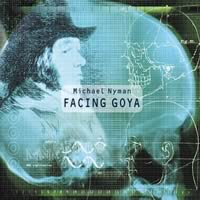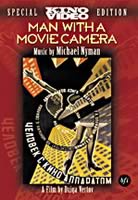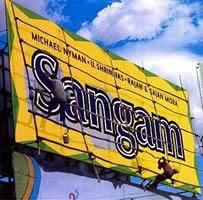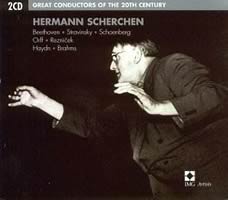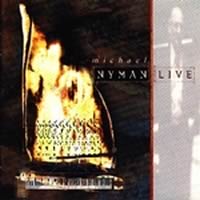The Nyman Bug
|
Grant Chu Covell [March 2004.] I’m compelled to explain my infrequent Michael Nyman binges. Every now and again, weeks pass during which I listen to one composer, usually Sibelius or Nielsen. My most recent indulgence has been Nyman, every recording I can get my hands on, though not to the exclusion of others. I rented several videos just to hear their Nyman scores. Favorite pieces retain their status, joined by a few new discoveries. To home in on Nyman’s appeal: his brazenness and fast-moving chord progressions. Nyman is best when he hints at his roots and straddles the ages. Long before he became a big name, he studied musicology and composition with Alan Bush and Thurston Dart. Nyman’s as big a Handel and Purcell expert as can be found, having edited editions of both. (Nyman regards Purcell as the all-time best British composer.) His unfinished Ph.D. was on catches, canons and rounds in 16th- and 17th-century English music. Aha, thinks the knowing listener. Nyman went on to collect folksongs in Romania, preferring to capture a live performance’s spark rather than a sterile ethnomusical example for posterity. A journalistic career (he was the first to apply “minimalism” to music) culminated with the authoritative 1974 study, Experimental Music: Cage and Beyond. Spurred by Harrison Birtwistle to craft several arrangements, Nyman continued to write for the ensemble he had formed. The momentum proved unstoppable. Nyman was soon scoring movies, writing operas, and touring with his band. Let’s look at an early opus in Nyman’s trademark style. Written for his band, In Re Don Giovanni (1977) is a brash transcription of a beloved Mozart / Da Ponte aria, Leporello’s “Madamina, il catalogo è questo.” (Counting seems to be a Nyman fixation.) In repeated staccato, treble strings and piano hammer brightly though a chord progression they will repeat eight times. At the third pass saxophones, trombone and bass guitar add a punchy torso. On the fifth we get trumpet and piccolo on the top. Leporello’s line appears on the trombone the seventh way through. In less than three minutes In Re is over. In Re is topsy-turvy. Top and bottom accompany a melody buried in the middle. Traditional instrument roles are reversed. The melody is in the trombone while the strings accompany. Listen again. The chords don’t follow strict counterpoint and strong beats don’t fit into eight-bar phrases. The third time through you realize that it’s a 15-bar pattern. Pull your Don Giovanni score off the shelf, and you’ll be surprised to see that all these details are in Mozart’s original, the 15-bars, the strings’ repeated chords, and the instrument choices and material. Whoa. Surprisingly close to Mozart’s original, In Re Don Giovanni seems simple, but it ought to be in textbooks, a consummate bridging of past and present, inside and out. Nyman’s since arranged the piece for string quartet. This hybridization of old and new reaches its peak with the music for Peter Greenaway’s 1982 movie The Draughtsman’s Contract. Rocketing saxophones and strings bounce through cleverly assembled Purcell and Purcell-like bits. Nyman admits he borrowed basslines and grounds directly. The score fits perfectly with Greenaway’s outré Restoration depiction, a period piece that makes no apologies for slithering out of costume. A later Greenaway-Nyman match, The Cook, the Thief, His Wife and Her Lover (1989), delivers a similar saucy impact. In the best Nyman, you can almost see the chords undulate as if projected onto the big screen. The composer has professed his fondness for the workaday I-vi-IV-V progression, common to both pop and Purcell. A perfect example is the bassline to the carefree waltz motif (“Sheep ’n’ Tides”) from the score for Greenaway’s Drowning by Numbers (1988). (Greenaway is also obsessed with counting and lists.) Nyman derived the movie’s entire score from the slow movement of Mozart’s Sinfonia Concertante for violin and viola.
But who wants to sing the same old song? You can’t blame Nyman for changing his tune. Recent work reveals a distance from the composer’s salad days. Facing Goya (2000) is an opera on WarnerClassics 0927-45342-2. Despite a fascinating plot combining genius, genetics, eugenics and Goya, the music falls flat. I wanted more of Draughtsman’s snootiness. Gone is In Re Don Giovanni’s razor-like clarity. Nyman’s 2002 score to the acclaimed Russian silent, Dziga Vertov’s Man with a Movie Camera (1929, Kino) works well. Vertov’s movie is a spectacular visual treat, abrupt editing and double exposures chronicling Soviet life after the Russian Revolution. The film’s novelty is reflected in the DVD’s menu with its rotating concentric circles. Much of Nyman’s Man with a Movie Camera score is propulsive, enhancing the film’s bustle. The composer makes no attempt to synchronize with rhythmic or repetitive onscreen events. Slower music contextualizes the disjunctive experience of watching historic reels against a contemporary score. Then again, throughout the movie we see cameramen at work. Famous images include a cameraman with tripod miniaturized on a camera’s top, and an eye superimposed onto a camera’s lens. Nyman’s band is recorded closely. A distracting wordless singer (countertenor?) materializes infrequently. One repeating theme hints at Stravinsky’s Symphony in Three Movements (1945), hardly an unthinkable allusion. It’s well-documented that Chinese wartime newsreel footage inspired Stravinsky. The ever-astute Nyman would know this.
Is the reader familiar with Bollywood? In the “And Now for Something Completely Different” category, the 2003 “Sangam” (Warner 0927 49551-2) captures Nyman’s joyful collaboration with several leading Indian master musicians. “Sangam,” Hindi for “coming together” or “meeting point,” reflects Nyman’s continuing interest in music outside the European classical tradition. Three Ways of Describing Rain highlights the renowned Misra brothers, Rajan and Sajan, who sing spectacularly. Compiling the Colours (or Samhitha in Hindi) is a showpiece for U. Shrinivas’ electric mandolin. Shrinivas is a phenomenal player, always dominating the vibrant 30-minute concerto, continual variations on a catchy pentatonic bass riff. Nyman’s Band blends effortlessly with the Indians. Neither tradition suffers, nothing is diluted.
The compulsive collector will require Not Necessarily “English Music” (EMF CD 036), a double-set historian / musician David Toop assembled in conjunction with Leonardo Music Journal. Late on the second disc, Nyman’s first ensemble, the Campiello Band, plays an arrangement of the Miserere from Verdi’s Il Trovatore, no relation to the Miserere, a setting of Psalm 51, embedded in The Cook, the Thief, His Wife and Her Lover. Audience noise combined with a poor recording lends a Spike Jones atmosphere to the March 3, 1977 artifact. This isn’t a hidden gem. The snippet sounds like a high-school recital. It’s no wonder Nyman hasn’t lent any commentary. However, Toop’s collection is remarkable, offering windows onto British experimenters working between 1960 and ’77: Howard Skempton, Derek Bailey, Steve Beresford, Cornelius Cardew, AMM, the Scratch Orchestra, et al. For more details see here and here. One treat was the obscure, made-for-TV filming of the 1986 “neurological opera” The Man Who Mistook His Wife for a Hat (FFH 1557). As filmed operas go, this is stranger than most. Based on Oliver Sacks’ celebrated case study, Nyman sets a doctor’s investigation of a musician who is gradually losing the ability to recognize and interpret what he sees. The 70-minute chamber opera is interrupted by a paleontologist dissecting a diseased brain and an interview with Sacks himself. The music backs dialog that demands visual components: a chess game (the moves are sung while one character plays in his head) and descriptions of paintings, family photos, and city streets.
My Nyman bender clarified favorite minimalist pieces. I gushed over Steve Martland’s Re-Mix because the endlessly repeated D-F-E bassline from Marais’ 1723 La Sonnerie de Ste. Geneviève du Mont de Paris takes a cameo. Some baroque teams squelch La Sonnerie’s minimalism while others luxuriate in the mindlessness. Minimalist harbingers in the Baroque or pre-Baroque are not uncommon. Recently reissued on CD is Orff’s Entrata, a 1933 orchestration of Byrd’s The Bells, conducted by Scherchen on EMI CLASSICS 7243 5 75956 2 9. Orff’s crystalline instrumentation builds grandly, lending optimism and heroism to an unassuming piece from the Fitzwilliam Virginal Book. This spree reaffirmed my dislike of a popular Nyman score. The Piano (1993) earned the composer great acclaim. I can’t stand this fricassee of Hanon etudes — to be played on the beach! The sing-song ballads tweaked with mangled Scottish tunes are inexorable. Nyman’s thing is snappy rhythms; one tune, “Here to There,” comes close to satisfying. However, when chord changes can’t be grasped in under 20 seconds, the music becomes meaningless. Nyman’s music is best when propelled by his band or any of a key cadre of players, such as violinist Alexander Balanescu and saxophonist John Harle. Though harsh at a single sitting, the first three string quartets performed by the Balanescu Quartet remain a revolutionary classic (Argo 433 093-2), putting to shame similar efforts by Glass and Julia Wolfe. A great example of Harle’s playing, and my favorite Nyman work, is the 1996-97 Double Concerto for Saxophone and Cello, with Julian Lloyd Weber, Nyman and the Philharmonia Orchestra (EMI CDC5564872). Cello and sax zip along energetically over perkily moving chords.
If you’re not sure about Nyman, then the 1994 “Michael Nyman Live” (Virgin 7243 8 39917 2 3) is the place to start. Or end. The live audience’s jubilance can make the unenthusiastic listener feel like a party pooper. This diverse program includes the original version of In Re Don Giovanni, an extended tune plucked from The Draughtsman’s Contract, a collaborative work with Moroccan musicians charmingly titled The Upside-Down Violin, and a syrupy suite from the abhorrent The Piano.
[More Grant Chu Covell]
[More
Nyman]
[Previous Article:
Dipping into the “EA” Bucket 1.]
[Next Article:
Balkan Snapshots]
|
